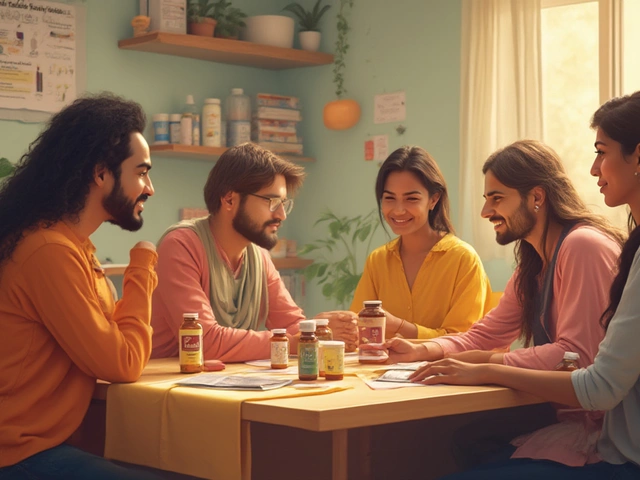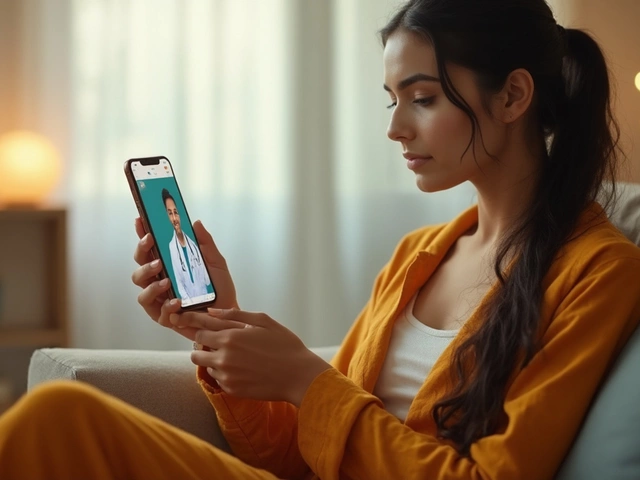
A few years back, gabapentin was something most folks hadn’t even heard of. Fast forward to today—if you’ve ever lived with nerve pain, wrestled with restless legs at night, or dealt with certain types of seizures, you or someone you know probably has. But here’s the twist: a medicine that used to be handed out pretty easily is now under a new cloud. Try picking up a repeat prescription for gabapentin, and suddenly you’re filling out more paperwork, getting extra questions from the pharmacist, or even told you can’t pick it up for someone else. What changed? Is gabapentin now a controlled substance? Not just in the US, but right here in the UK too? And what does that even mean for your next prescription?
What is Gabapentin and Why Do People Use It?
Gabapentin first hit the market in the UK back in 1993 under the brand name Neurontin. Its original job? Helping people with epilepsy manage seizures when older medications weren’t cutting it. But gabapentin was a multi-tool in disguise. Fast-forward a few years, and doctors figured out it was also pretty effective for managing nerve pain—like the burning, stabbing misery of post-shingles neuralgia or diabetic neuropathy. If you’ve ever dealt with sciatica or pain that just doesn’t play by normal rules, you might’ve been offered gabapentin before anything else stronger.
How does it work? Here’s where the story is kind of wild. Gabapentin doesn’t mess directly with the usual opioid or common painkiller channels. It’s actually a synthetic cousin of GABA, a neurotransmitter that chills out the brain. But gabapentin doesn’t even turn up GABA directly—it works its magic by tweaking calcium channels in nerve cells, which has a knock-on effect of calming overexcited nerves. If traditional painkillers like paracetamol or ibuprofen felt useless for your nerve pain, gabapentin offers a totally different approach.
So, why has gabapentin been in the headlines? Unlike addictive painkillers (think: oxycodone, morphine), gabapentin wasn’t expected to be much of a target for misuse. It was considered “non-addictive,” and doctors prescribed it pretty freely for years—even for off-label uses like restless leg syndrome, anxiety, migraines, and hot flashes. This wide-open door led to a huge surge. By 2016 in England, the NHS was dishing out over 6.5 million prescriptions a year for gabapentin and its chemical sibling, pregabalin.
Unfortunately, word got around that gabapentin isn’t just for pain. When taken in high doses—especially mixed with other drugs or with alcohol—it can cause a sense of euphoria, drowsiness, or even mild hallucinations in some people. The National Programme on Substance Abuse Deaths (NPSAD) in the UK noticed a marked rise in fatalities linked to gabapentin misuse from 2009 onwards. Suddenly, police and hospitals were reporting cases of gabapentin being traded on the street, usually mixed with opioids for an extra dangerous high.
To sum up: gabapentin began as a revolutionary treatment for tricky cases of epilepsy and pain, but its rise in popularity has come with risks no one quite expected at the start. So what did governments do next?

Gabapentin Regulations in the UK, US, and Other Countries
For years, you could get gabapentin with a regular prescription—no special paperwork, no special rules. But as stories of misuse grew, regulators slammed on the brakes. The really big moment for the UK came on April 1, 2019. From that date on, gabapentin (along with pregabalin) was reclassified as a Class C controlled substance under the Misuse of Drugs Act 1971 and a Schedule 3 drug under the Misuse of Drugs Regulations 2001.
So, what do these new rules look like in practice?
- You can only get gabapentin with an in-person prescription (not repeat-ordered online or picked up by a neighbour without the right paperwork).
- No more than 30 days’ supply per prescription.
- Pharmacists now need stricter records. You’ll likely have to sign for receipt, just like with strong painkillers or sleeping tablets.
- If you lose your supply or prescription, getting a replacement is much harder.
- If you travel internationally, carrying gabapentin through airport security without proof could get you in trouble.
Why all this? Between 2008 and 2018, the Office for National Statistics (ONS) reported an over ten-fold increase in deaths related to gabapentin and pregabalin use in England and Wales. Hospitals saw a spike in people arriving after overdoses, usually from mixing these medications with heroin, methadone, or alcohol. So, the Home Office had to react.
How about the US? The answer is a bit more complicated. Gabapentin isn’t classified as a federally controlled substance in the US. But certain states—like Kentucky, West Virginia, and Tennessee—have set their own rules, listing gabapentin as a Schedule V controlled drug. There, you’ll face extra restrictions, similar to the UK. Pharmacists must monitor prescriptions even more closely, in a bid to stop people stockpiling them for misuse.
And what about elsewhere? In Australia, gabapentin isn’t as widely prescribed and is only available via special prescription. Some EU countries treat it more like a regular prescription drug. But there’s a global pattern: as soon as a country detects rising misuse or fatalities, the rules tighten up fast.
| Country/Region | Controlled Substance? | Classification | Year Rule Enforced |
|---|---|---|---|
| UK | Yes | Class C (Schedule 3) | 2019 |
| US (Federal) | No | None | — |
| US (KY, WV, TN, MI, VA, AL, ND, MN, OH) | Yes | Schedule V (state regulations) | 2016–2021 |
| Ireland | Yes | Controlled (Schedule 3) | 2023 |
| Australia | No (Extra controls) | Prescription only | — |
Got a road trip planned? Remember: drug laws change quickly. What seems normal at home can land you in deep water abroad.

Practical Tips for Gabapentin Users and Prescribers
If you’re already on gabapentin for nerve pain or seizures, you’re probably feeling this shift in the rules. Here’s the best advice for living with its new controlled status without letting it mess with your treatment.
- Stay organised. You can’t just pop into the chemist or reorder online and expect your prescription to be ready. Mark prescription renewal dates in your calendar at least a week ahead. If appointments with your prescriber get delayed, you may end up with a gap in medication—a nightmare for pain and seizures.
- Plan for travel. Flying from Birmingham to Spain in the summer? Take your prescription with you, clearly labelled, and—if possible—bring a letter from your doctor. Some countries demand official import permits if you’re carrying over a month’s supply.
- Never share your medicine. Yes, it might seem harmless to hand a couple of tabs to a friend in pain, but legally, that’s supply of a controlled substance now—even if you don’t charge a penny.
- Store carefully. Since gabapentin is a controlled substance, you should store it as securely as you would a strong painkiller, outside reach of kids or housemates who might be curious.
- Let your prescriber know about all other medications. Gabapentin mixes dangerously with opioids, sleeping tablets, and lots of alcohol. Always mention if you’ve changed or stopped any meds yourself.
- Watch for side effects. Gabapentin can make you feel dizzy, drowsy, or foggy-headed, especially at first. It’s important to see how your body reacts before driving or using machinery.
- Don’t go cold turkey. Suddenly stopping gabapentin may cause withdrawal symptoms like anxiety, trouble sleeping, feeling sick, or even seizures if you’ve been using it a while. If you want to stop, work with your doctor on a careful, slow reduction.
- Be honest with your pharmacist. If you’ve lost your gabapentin or think someone has stolen it, tell the chemist and your GP. Official losses or thefts get logged, but covering it up only makes future pickups harder.
Want to go deeper? Research from Public Health England has shown that men over 45, especially those already taking other prescription painkillers, are at the highest risk of misusing gabapentin in the UK. Prescribers are now strongly advised to check for signs like “doctor-shopping” (visiting multiple GPs to get extra prescriptions) or repeat requests for missing medication. Even small towns see this. In Birmingham alone, local NHS trusts have set up special monitoring systems for controlled painkillers, including gabapentin and pregabalin. Pharmacists are trained to double-check prescription histories when requests come in too soon or sound suspicious.
And here’s a tip for anyone who feels more tired or confused on gabapentin: don’t just accept it as the price of pain relief. Tell your GP. Doses can often be adjusted, or you might be switched to a different medication that’s just as effective but less likely to leave you feeling zonked out during the day. Never mix gabapentin with sedating antihistamines or sleep tablets without letting your prescriber know—it’s a combo that can lead to dangerous breathing problems.
Stepping back, if you’re new to all this—it’s worth remembering that gabapentin, even as a controlled substance, is still a really important tool for thousands of people dealing with pain or seizures that ruin daily life. These new rules aren’t meant to shame patients or block access to treatment for those who need it. It’s all about making sure you get safe, monitored care and that stocks can’t be siphoned off for misuse.
To wrap it up: Yes, gabapentin is now a controlled substance in the UK and a handful of US states. The climate of prescriptions is getting stricter, and for good reason. But with a little organisation, open communication, and the right medical advice, people living with pain or epilepsy can still rely on it as part of their toolbox. The key is never to see new rules as punishment, but simply as another way to keep you, and everyone around you, a bit safer.





Rohan Talvani
I am a manufacturing expert with over 15 years of experience in streamlining production processes and enhancing operational efficiency. My work often takes me into the technical nitty-gritty of production, but I have a keen interest in writing about medicine in India—an intersection of tradition and modern practices that captivates me. I strive to incorporate innovative approaches in everything I do, whether in my professional role or as an author. My passion for writing about health topics stems from a strong belief in knowledge sharing and its potential to bring about positive changes.
view all postsWrite a comment